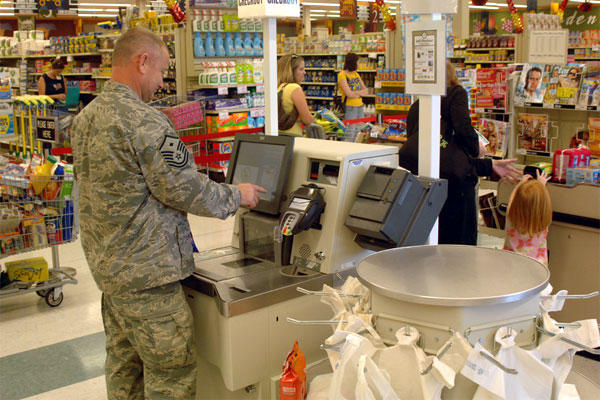 Military Update: Commissary shoppers have long suspected that they save more on groceries at some bases than at others, compared to local commercial stores. Defense Commissary Agency (DeCA) will soon show them how right they are.
Military Update: Commissary shoppers have long suspected that they save more on groceries at some bases than at others, compared to local commercial stores. Defense Commissary Agency (DeCA) will soon show them how right they are.
Sometime next year DeCA will begin to calculate and publish separate cost-saving averages for commissary shopping across seven newly defined regions that will encompass all of the United States.
The regional savings calculations are to serve as a more accurate baseline for valuing the benefit than the national average of “30 percent or more” DeCA has touted for years. That national average, based on annual price comparisons of most items sold in commissaries, fails to reflect the wide disparities in savings some shoppers experience locally.
Once regional savings are calculated, DECA will commit to sustaining them as it experiments with variable pricing and selling its own private label products. Both concepts, used widely by retail grocers, are seen as key to lowering the $1.4 billion taxpayer subsidy now needed annually to operate commissaries. At least some of those dollars, military leaders have told Congress, need to be saved and diverted to more pressing readiness needs.
As a first step to comply with new efficiency goals for base grocers, Congress tasked Defense officials to develop a plan to calculate commissary savings more like the private sector would do.
“For the first time through this new approach, we will compare our prices with local grocers on a more frequent basis to better inform our customers of potential cost savings over stores” nearby, said Joseph H. Jeu, DeCA's director, in announcing the new method for calculating savings.
He added that the new method “will not impact the prices our customers pay or the dollar benefit that they receive.”
The current method of estimating savings produces only a “global view,” officials said. For the continental United States, DeCA yearly directs a comparison of commissary prices with national average prices on 38,000 grocery items having a Universal Product Code. Research firm Nielson maintains the data. To compare meat and produce prices, DeCA relies on in-store audits of randomly selected commissaries with nearby retailers.
Commissary price comparisons include the five-percent surcharge at checkout. Commercial prices include all applicable sales taxes.
The new method will compare prices on only about 900 of the most popular items sold at each commissary and prices for its strongest three competitive retailers off base. Done once a year, the price comparisons will include retailers’ private label brands and “items from across the store,” including meat and produce. Individual commissary results then will be combined with other base stores to calculate a regional average of savings.
The regional averages will be the savings levels DeCA promises to maintain, said Joyce Wessel Raezer, executive director of National Military Family Association. “So as they negotiate prices with suppliers, as they explore private label and variable pricing, this becomes their savings floors.”
Raezer said it’s important for DeCA to be “very transparent” on the 900-item market basket it uses, how the product mix is adjusted and what competing retailers are used to make price comparisons.
Because commissaries now sell national brands and set identical prices across the system (cost plus a surcharge), military shoppers in a high cost area like San Diego save substantially more compared to local prices than do shoppers at a low-cost area like Fort Sill. Some of that savings disparity will be captured in the regional baseline savings, Raezer said, and that’s okay.
Why should shoppers have to pay more for groceries when they live in high cost-of-living area, she asked. So it’s right that the new method show “the reality of savings people get now.” It’s also right that DeCA stop using “that 30 percent figure because it doesn’t reflect actual savings.”
DoD officials haven’t announced how regions will be set except to note one will be called South Central and another will include both Hawaii and Alaska. DeCA also will continue to use Nielson data on 38,000 items to compare prices nationally and will begin to update monthly versus yearly. But the purpose of that Nielson data will be to help verify that the regional method of calculating customer savings “stays constant,” officials said.
Congress supports Defense plans to reform how commissaries purchase, price, promote and sell groceries, using new authorities to test variable pricing by store or region, private label brands and the conversion of base grocers to non-appropriated fund activities like base exchanges.
The key condition Congress set is that patron savings be preserved as officials strive to modernize store operations and lower DeCA funding by more than $500 million a year by 2021.
“This is real complicated stuff they’re doing here,” said Raezer. “It’s beyond what most retail grocery stores go through. They’re putting themselves on the line, saying we’re going to hold to these savings.”
When the first figures come out next year, Raezer predicted, patrons are going to be surprised at how small commissary savings are in some locations. DeCA will need to give assurances that “this is just the floor for savings…not the ceiling and it will “work hard to generate more,” she said.
In a May report to Congress, Defense officials dismissed as unachievable the idea of some lawmakers that commissaries can achieve “budget neutrality,” that is, operate without taxpayer support. That would wipe out savings and destroy the highly prized benefit, officials concluded.
Over time, however, commissary prices no longer will be based on the simple formula of cost plus a five-percent surcharge. The May report said that formula “prevents DeCA from fully capturing the margin benefits of trying to lower the cost of goods sold through private brands or by varying the price of product locally.
“Under cost-plus pricing, any reduction in DeCA's cost of goods sold would have to be passed directly to the patron” rather than be used to reduce the annual appropriation for commissaries. “Thus while managing the cost of goods sold is a key driver of profitability for private sector grocers, this practice is currently largely irrelevant” for commissaries.
That will change once DeCA knows what savings it must protect.
Send comments to Military Update, P.O. Box 231111, Centreville, VA, 20120, email milupdate@aol.com or twitter: Tom Philpott @Military_Update.
# # # #
Tom Philpott has been breaking news for and about military people since 1977. After service in the Coast Guard, and 17 years as a reporter and senior editor with Army Times Publishing Company, Tom launched "Military Update," his syndicated weekly news column, in 1994. "Military Update" features timely news and analysis on issues affecting active duty members, reservists, retirees and their families.
Visit Tom Philpott's Military Update Archive to view his past articles.
Tom also edits a reader reaction column, "Military Forum." The online "home" for both features is Military.com.
 Tom's freelance articles have appeared in numerous magazines including The New Yorker, Reader's Digest and Washingtonian.
Tom's freelance articles have appeared in numerous magazines including The New Yorker, Reader's Digest and Washingtonian.
His critically-acclaimed book, Glory Denied, on the extraordinary ordeal and heroism of Col. Floyd "Jim" Thompson, the longest-held prisoner of war in American history, is available in hardcover and paperback.




